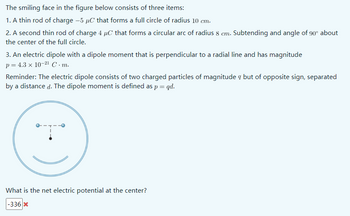
College Physics
11th Edition
ISBN: 9781305952300
Author: Raymond A. Serway, Chris Vuille
Publisher: Cengage Learning
expand_more
expand_more
format_list_bulleted
Question

Transcribed Image Text:The smiling face in the figure below consists of three items:
1. A thin rod of charge -5 μC that forms a full circle of radius 10 cm.
2. A second thin rod of charge 4 μC that forms a circular arc of radius 8 cm. Subtending and angle of 90° about
the center of the full circle.
3. An electric dipole with a dipole moment that is perpendicular to a radial line and has magnitude
p = 4.3 × 10-21 C.m.
Reminder: The electric dipole consists of two charged particles of magnitude but of opposite sign, separated
by a distance d. The dipole moment is defined as p = qd.
What is the net electric potential at the center?
-336x
Expert Solution
This question has been solved!
Explore an expertly crafted, step-by-step solution for a thorough understanding of key concepts.
Step by stepSolved in 2 steps with 1 images

Knowledge Booster
Similar questions
- please help asap!arrow_forwardA.) Which of the following statements are true? Choose all that are. The charge on particle A is 6 µC. The charge on particle B is 346 µC. The two particles are 58 cm apart. FE,A on B = FE,B on A- Electrostatically, electrons are repelled by neutrons. Quadrupling the distance between two charges increases the electric force between them by a factor of 16. For two charges with opposite polarities, FE > 0. In Coulomb's Law, k is the spring constant.arrow_forward5arrow_forward
- A very large plane of charge with o= 4.0x10 c/m² lies in the y-z plane. A single charge Q=3.0x 10 C lies on the +x axds at x- 2.0 m. The electric field in N/C at x=5.0 m has the value a. 104. b. 226. c. 300. d. 526. e. 752.arrow_forward1. Three identical metallic conducting spheres carry the following charges: 91 = +5.00 μC, q2 = +1.40 µC, and 93 -9.20 μC. The spheres that carry the charges 9₁ and 92 are brought into contact. Then they are separated. After that, one of those two spheres is brought into contact with the third sphere that carries the charge 93; those two are then separated as well. ROJS a) What is the final charge on the third sphere?60 SS μC sf60 s60 s ssf60 ssfo ssf603 60 ssf60 ssiarrow_forward10. Three point-like charges are placed at the corners of an equilateral triangle as shown in the figure. Each side of the triangle has a length of 20.0 cm, and the point (C) is located half way between qı and q3 along the side. Find the magnitude of the electric field at point (C). Let q1 = -1.60 µC, q2 = +2.60 µC, and q3 = +5.20 µC. N/C oof19 00 q3 19.0of19.0of19.oof19 oof19.of of19 0of19 0of19 0of19.oof19 oof of19 0of19 oof19 0arrow_forward
- A small, 2 g plastic ball carrying a charge 5c is suspended by a 20 cm long string in a uniform electric field If the ball is in equilibrium when the 0=15° , the magnitude of E= E 15.0° Select one: O a. 1 N/c b. 2952000 N/C O c. 1X 10^(-3) N/c O d. 1000 N/c O e. 0.1 N/carrow_forward1. A point charge q₁ –5 µC located at (x = 0, y = 0.4 m, z = 0) is moving with speed 9 × 10ª m/s. The charge q₁ is moving in the xy-plane, and its velocity ₁ makes a 45° angle with the y-axis as shown below. Another point charge 92 8 μC is located at (x = 0, y = 0, z = 0.3 m) and is moving with velocity 6.5 × 10-4 m/s in the +z-direction. = x - V₂ 92 Z V₁ 45° 91 y (a) What is the magnetic field produced by 9₁ at the location of 9₂? (b) What is the magnetic force exerted on 92 by 9₁?arrow_forwardQuestion= Two small spheres spaced 20.0 cmcm apart have equal charge. 1. How many excess electrons must be present on each sphere if the magnitude of the force of repulsion between them is 5.78×10−21 NN? Express your answer as number of electrons.arrow_forward
arrow_back_ios
arrow_forward_ios
Recommended textbooks for you
 College PhysicsPhysicsISBN:9781305952300Author:Raymond A. Serway, Chris VuillePublisher:Cengage Learning
College PhysicsPhysicsISBN:9781305952300Author:Raymond A. Serway, Chris VuillePublisher:Cengage Learning University Physics (14th Edition)PhysicsISBN:9780133969290Author:Hugh D. Young, Roger A. FreedmanPublisher:PEARSON
University Physics (14th Edition)PhysicsISBN:9780133969290Author:Hugh D. Young, Roger A. FreedmanPublisher:PEARSON Introduction To Quantum MechanicsPhysicsISBN:9781107189638Author:Griffiths, David J., Schroeter, Darrell F.Publisher:Cambridge University Press
Introduction To Quantum MechanicsPhysicsISBN:9781107189638Author:Griffiths, David J., Schroeter, Darrell F.Publisher:Cambridge University Press Physics for Scientists and EngineersPhysicsISBN:9781337553278Author:Raymond A. Serway, John W. JewettPublisher:Cengage Learning
Physics for Scientists and EngineersPhysicsISBN:9781337553278Author:Raymond A. Serway, John W. JewettPublisher:Cengage Learning Lecture- Tutorials for Introductory AstronomyPhysicsISBN:9780321820464Author:Edward E. Prather, Tim P. Slater, Jeff P. Adams, Gina BrissendenPublisher:Addison-Wesley
Lecture- Tutorials for Introductory AstronomyPhysicsISBN:9780321820464Author:Edward E. Prather, Tim P. Slater, Jeff P. Adams, Gina BrissendenPublisher:Addison-Wesley College Physics: A Strategic Approach (4th Editio...PhysicsISBN:9780134609034Author:Randall D. Knight (Professor Emeritus), Brian Jones, Stuart FieldPublisher:PEARSON
College Physics: A Strategic Approach (4th Editio...PhysicsISBN:9780134609034Author:Randall D. Knight (Professor Emeritus), Brian Jones, Stuart FieldPublisher:PEARSON

College Physics
Physics
ISBN:9781305952300
Author:Raymond A. Serway, Chris Vuille
Publisher:Cengage Learning

University Physics (14th Edition)
Physics
ISBN:9780133969290
Author:Hugh D. Young, Roger A. Freedman
Publisher:PEARSON

Introduction To Quantum Mechanics
Physics
ISBN:9781107189638
Author:Griffiths, David J., Schroeter, Darrell F.
Publisher:Cambridge University Press

Physics for Scientists and Engineers
Physics
ISBN:9781337553278
Author:Raymond A. Serway, John W. Jewett
Publisher:Cengage Learning

Lecture- Tutorials for Introductory Astronomy
Physics
ISBN:9780321820464
Author:Edward E. Prather, Tim P. Slater, Jeff P. Adams, Gina Brissenden
Publisher:Addison-Wesley

College Physics: A Strategic Approach (4th Editio...
Physics
ISBN:9780134609034
Author:Randall D. Knight (Professor Emeritus), Brian Jones, Stuart Field
Publisher:PEARSON